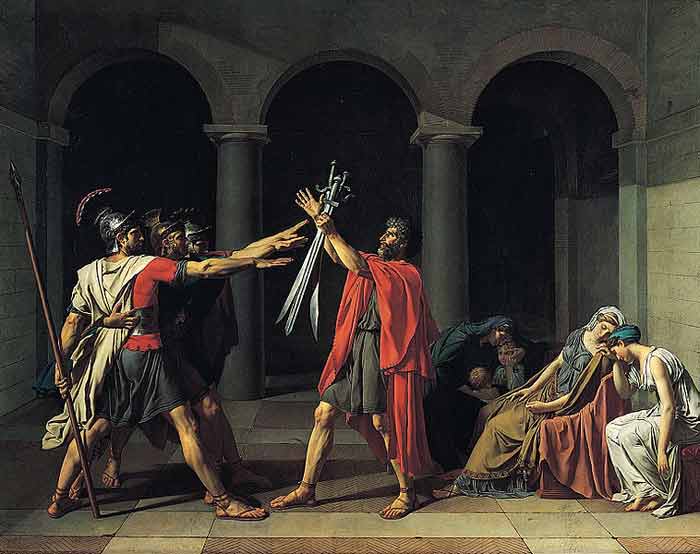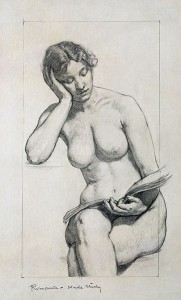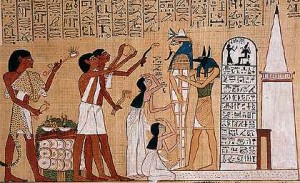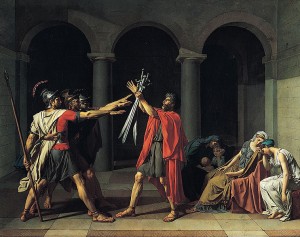Fine Art: Figurative art

sometimes written as figurativism, describes artwork—particularly paintings and sculptures—which are clearly derived from real object sources, and are therefore by definition representational.

Nude study, 1896, by figurative art advocate Kenyon Cox.
Figurative art Definition
The term “figurative art” is often taken to mean art which represents the human figure, or even an animal figure, and, though this is often the case, it is not necessarily so:
Since the arrival of abstract art the term figurative has been used to refer to any form of modern art that retains strong references to the real world.
Painting and sculpture can therefore be divided into the categories of figurative, representational and abstract, although, strictly speaking, abstract art is derived (or abstracted) from a figurative or other natural source. However, the term is sometimes used as a synonym for non-representational art and non-objective art, i.e. art which has no derivation from figures or objects.
Figurative art Formal elements
The formal elements, those aesthetic effects created by design, upon which figurative art is dependent, include line, shape, color, light and dark, mass,volume, texture, and perspective, although it should be pointed out that these elements of design could also play a role in creating other types of imagery — for instance abstract, or non-representational or non-objective two-dimensional artwork.
Figurative art Evolution

Ancient Egyptian painting
Figurative art is itself based upon a tacit understanding of abstracted shapes: the figure sculpture of Greek antiquity was not naturalistic, for its forms were idealized and geometric. Ernst Gombrich referred to the strictures of this schematic imagery, the adherence to that which was already known, rather than that which is seen, as the “Egyptian method”, an allusion to the memory-based clarity of imagery in Egyptian art.

Jacques-Louis David. Oath of the Horatii, 1784.
Eventually idealization gave way to observation, and a figurative art which balanced ideal geometry with greater realism was seen in Classical sculpture by 480 B.C. The Greeks referred to the reliance on visual observation as mimesis. Until the time of the Impressionists, figurative art was characterized by attempts to reconcile these opposing principles.
The rise of the Neoclassical art of Nicholas Poussin and Jacques-Louis David ultimately engendered the realistic reactions of Gustave Courbet and Édouard Manet.
sometimes written as figurativism, describes artwork—particularly paintings and sculptures—which are clearly derived from real object sources, and are therefore by definition representational.

Nude study, 1896, by figurative art advocate Kenyon Cox.
Figurative art Definition
The term “figurative art” is often taken to mean art which represents the human figure, or even an animal figure, and, though this is often the case, it is not necessarily so:
Since the arrival of abstract art the term figurative has been used to refer to any form of modern art that retains strong references to the real world.
Painting and sculpture can therefore be divided into the categories of figurative, representational and abstract, although, strictly speaking, abstract art is derived (or abstracted) from a figurative or other natural source. However, the term is sometimes used as a synonym for non-representational art and non-objective art, i.e. art which has no derivation from figures or objects.
Figurative art Formal elements
The formal elements, those aesthetic effects created by design, upon which figurative art is dependent, include line, shape, color, light and dark, mass,volume, texture, and perspective, although it should be pointed out that these elements of design could also play a role in creating other types of imagery — for instance abstract, or non-representational or non-objective two-dimensional artwork.
Figurative art Evolution

Ancient Egyptian painting
Figurative art is itself based upon a tacit understanding of abstracted shapes: the figure sculpture of Greek antiquity was not naturalistic, for its forms were idealized and geometric. Ernst Gombrich referred to the strictures of this schematic imagery, the adherence to that which was already known, rather than that which is seen, as the “Egyptian method”, an allusion to the memory-based clarity of imagery in Egyptian art.

Jacques-Louis David. Oath of the Horatii, 1784.
Eventually idealization gave way to observation, and a figurative art which balanced ideal geometry with greater realism was seen in Classical sculpture by 480 B.C. The Greeks referred to the reliance on visual observation as mimesis. Until the time of the Impressionists, figurative art was characterized by attempts to reconcile these opposing principles.
The rise of the Neoclassical art of Nicholas Poussin and Jacques-Louis David ultimately engendered the realistic reactions of Gustave Courbet and Édouard Manet.


This Post Has 0 Comments